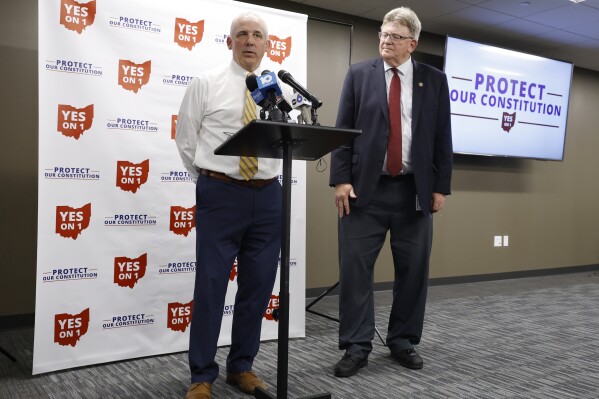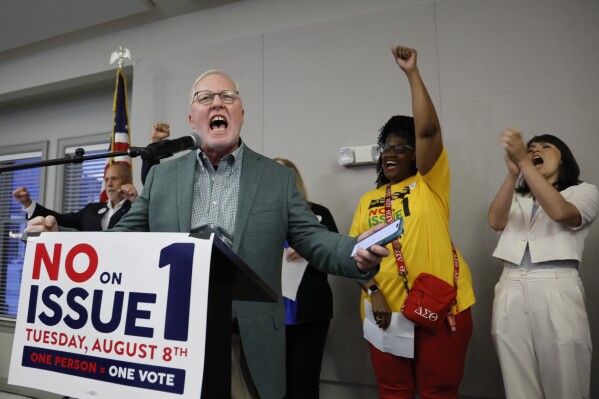Ohio attorney general rejects language for amendment aimed at reforming troubled political mapmaking
COLUMBUS, Ohio (AP) — The Ohio Attorney General’s Office rejected petition language Wednesday for a constitutional amendment aimed at remaking the state’s troubled system for drawing political maps, determining that it failed to present a fair and truthful summary of what is proposed.
In announcing the determination, Republican Dave Yost’s office said, “The decision underscores the importance of precise, comprehensive and unbiased summaries to enable voters to make informed decisions.”
The group Citizens Not Politicians, which includes two former Ohio Supreme Court justices, aims to place the proposal on next year’s fall ballot.
Spokesman Chris Davey said rejections are not unusual in a proposed amendment’s early stages.
 The failed Ohio amendment reflects Republican efforts nationally to restrict direct democracy
The failed Ohio amendment reflects Republican efforts nationally to restrict direct democracy
 Ohio vote shows enduring power of abortion rights at ballot box, giving Democrats a path in 2024
Ohio vote shows enduring power of abortion rights at ballot box, giving Democrats a path in 2024
 Ohio utility that paid federal penalty says it’s now being investigated by a state commission
Ohio utility that paid federal penalty says it’s now being investigated by a state commission
“We believe our summary was accurate,” he said in a statement. “But we will review the Attorney General’s guidance, will make necessary adjustments and will collect new signatures with our broad, statewide, nonpartisan coalition of partners to refile as soon as possible because it’s time for citizens and not politicians to draw Ohio’s legislative maps.”
The proposal calls for replacing the Ohio Redistricting Commission, which currently comprises three statewide officeholders and four state lawmakers, with an independent body selected directly by citizens.
The effort follows the repeated failure under the existing structure to produce constitutional maps. Courts rejected two congressional maps and five sets of Statehouse maps as gerrymandered. Amid the court disputes, Ohio’s elections were allowed to proceed last year under the flawed maps.
The two former Supreme Court justices who are part of Citizens Not Politicians are retired Chief Justice Maureen O’Connor, a Republican; and Yvette McGee-Brown, a Democrat. While still on the court, O’Connor cast repeated swing votes to rule that the maps unconstitutionally benefited Republicans, siding with the three Democrats.
The proposed amendment calls for replacing the Redistricting Commission with a 15-member citizen panel of Republicans, Democrats and independents. The Ohio Citizens Redistricting Commission’s makeup would represent a geographic and demographic mix.
The amendment also would bar current and former politicians, political party officials, lobbyists and high-giving political donors from sitting on the commission. To ensure maps are fair and impartial, districts would be precluded from discriminating against or favoring a political party or individual politician.
Critics say the proposed setup could be easily manipulated, including by groups like the well-funded National Democratic Redistricting Commission, which is led by a former U.S. attorney general.
“So-called citizen led commissions are anything but that, they are proxy votes and puppets of partisan special interest groups like Eric Holder’s NDRC,” said John Fortney, a spokesman for state Senate President Matt Huffman, a Republican who helped draw maps last year.
Voters overwhelmingly supported creation of Ohio’s existing system in two votes: One in 2015 that created the bipartisan Ohio Redistricting Commission to draw Statehouse maps, and another in 2018 that extended the commission’s role to drawing U.S. House districts and added a role for the Ohio General Assembly.
A crucial flaw of the current system is it lacks any enforcement mechanism for requiring mapmakers to fix proposals rejected by the courts.
Under current rules, if both political parties approve new boundaries, the maps will be in place for a decade. Support by just one party results in a four-year map.
But seeming incentives for bipartisan compromise failed. Democrats didn’t cast a single vote for any of the final maps, which were all Republican-drawn, and the GOP-controlled commission defied repeated instructions from the state Supreme Court to more closely align district boundaries with Ohio’s political composition.
Republican legislative leaders appealed an Ohio Supreme Court decision regarding the congressional map to the U.S. Supreme Court, which has directed the Ohio court to reassess the map. That was after the national high court’s June ruling in a North Carolina case rejecting an expansive version of the so-called independent state legislature theory, which holds that lawmaking bodies have absolute power in setting the rules of federal elections and cannot be overruled by state courts.
Republican Gov. Mike DeWine has yet to reconvene the current commission, as required, to fix the state’s Ohio House and Ohio Senate maps. A member of the Ohio Redistricting Commission as governor, DeWine has said he doesn’t believe politicians should have the job but has stopped short of endorsing the ballot amendment.
“The system we have today doesn’t work very well,” he told reporters this week. “No great revelation to anyone in this room who watched this unfold. It just didn’t work very well.”
Disclaimer: The copyright of this article belongs to the original author. Reposting this article is solely for the purpose of information dissemination and does not constitute any investment advice. If there is any infringement, please contact us immediately. We will make corrections or deletions as necessary. Thank you.



